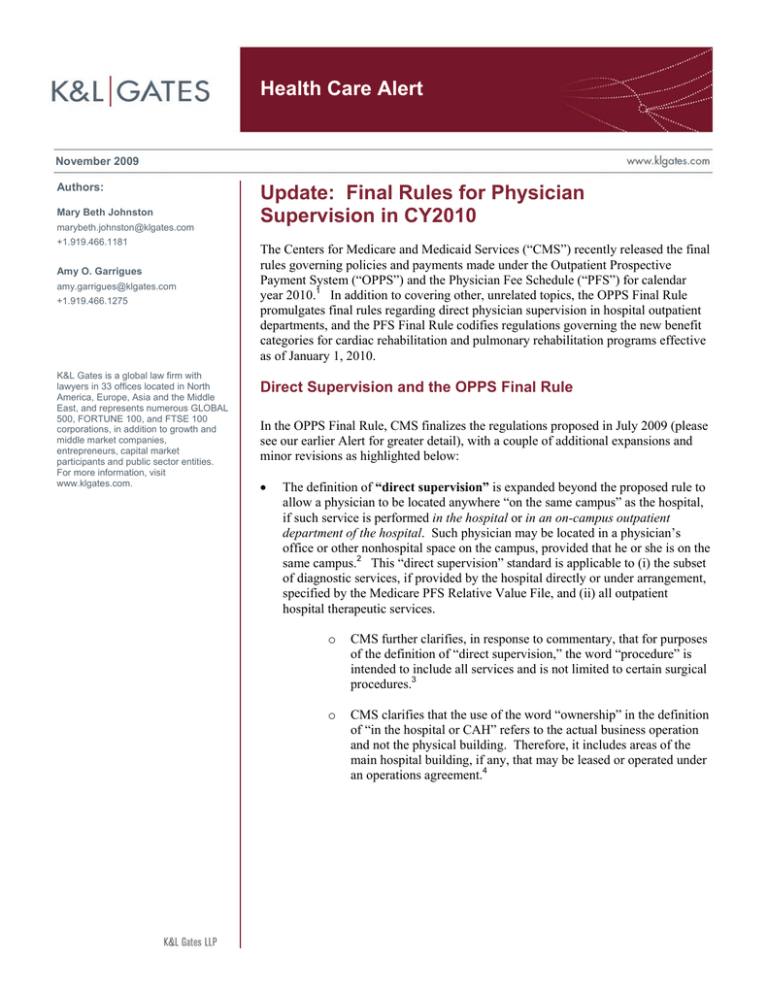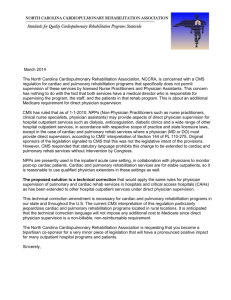
Health Care Alert
November 2009
Authors:
Mary Beth Johnston
marybeth.johnston@klgates.com
+1.919.466.1181
Amy O. Garrigues
amy.garrigues@klgates.com
+1.919.466.1275
K&L Gates is a global law firm with
lawyers in 33 offices located in North
America, Europe, Asia and the Middle
East, and represents numerous GLOBAL
500, FORTUNE 100, and FTSE 100
corporations, in addition to growth and
middle market companies,
entrepreneurs, capital market
participants and public sector entities.
For more information, visit
www.klgates.com.
Update: Final Rules for Physician
Supervision in CY2010
The Centers for Medicare and Medicaid Services (“CMS”) recently released the final
rules governing policies and payments made under the Outpatient Prospective
Payment System (“OPPS”) and the Physician Fee Schedule (“PFS”) for calendar
year 2010.1 In addition to covering other, unrelated topics, the OPPS Final Rule
promulgates final rules regarding direct physician supervision in hospital outpatient
departments, and the PFS Final Rule codifies regulations governing the new benefit
categories for cardiac rehabilitation and pulmonary rehabilitation programs effective
as of January 1, 2010.
Direct Supervision and the OPPS Final Rule
In the OPPS Final Rule, CMS finalizes the regulations proposed in July 2009 (please
see our earlier Alert for greater detail), with a couple of additional expansions and
minor revisions as highlighted below:
The definition of “direct supervision” is expanded beyond the proposed rule to
allow a physician to be located anywhere “on the same campus” as the hospital,
if such service is performed in the hospital or in an on-campus outpatient
department of the hospital. Such physician may be located in a physician’s
office or other nonhospital space on the campus, provided that he or she is on the
same campus.2 This “direct supervision” standard is applicable to (i) the subset
of diagnostic services, if provided by the hospital directly or under arrangement,
specified by the Medicare PFS Relative Value File, and (ii) all outpatient
hospital therapeutic services.
o
CMS further clarifies, in response to commentary, that for purposes
of the definition of “direct supervision,” the word “procedure” is
intended to include all services and is not limited to certain surgical
procedures.3
o
CMS clarifies that the use of the word “ownership” in the definition
of “in the hospital or CAH” refers to the actual business operation
and not the physical building. Therefore, it includes areas of the
main hospital building, if any, that may be leased or operated under
an operations agreement.4
Health Care Alert
o
CMS makes a “technical change”
to the proposed language covering
services performed in off-campus
provider-based departments, such
that the definition of “direct
supervision” now specifies that the
physician must be “present in the
off-campus provider-based
department,” rather than the
proposed “on the premises of the
location.” CMS reiterates that it
would likely be “inappropriate” for
one physician to provide direct
supervision for all services
performed at a given off-campus
provider-based location.5
CMS emphasizes in commentary that
“immediately available” means without
interval of time and that the supervising
physician can neither be performing another
service that he or she cannot interrupt, nor “so
physically far away,” even if on the same
campus, that he or she cannot intervene
immediately.6 CMS notes that this is not to be
read so narrowly as to mandate that the
physician be located in the room next to the
room in which the service is performed.7
CMS also notes in commentary that, while not
required to be in the same department or
specialty, the capabilities of the supervising
physician must allow for him or her “to step in
and perform the service, not just to respond to
an emergency.”8 He or she must be able to take
over the performance of the procedure or change
the course of treatment, if necessary.
CMS expands the list of non-physician
practitioners that are allowed to provide the
requisite supervision for certain outpatient
therapeutic services to include licensed clinical
social workers. CMS retains the requirements
that (i) all non-physician practitioners providing
direct supervision must be able to personally
perform the procedures that they are supervising
under state law, hospital bylaws, and other
requirements, and (ii) non-physician
practitioners cannot supervise cardiac
rehabilitation and pulmonary rehabilitation
programs, or diagnostic tests requiring direct
supervision.
CMS clarifies that all of these rules also apply
to critical access hospitals by adding “or
CAH” after each use of the word “hospital.”
CMS clarifies, in commentary, that physical
therapy, occupational therapy, and speechlanguage pathology are not paid under the
OPPS and therefore are not subject to the direct
supervision regulations under 42 C.F.R. §
410.27.
CMS solicits comments as to whether the
supervision requirements for partial
hospitalization program services should be
the same for community health mental centers
and hospital outpatient departments.
Finally, CMS states that normal enforcement
mechanisms will be utilized in reviewing whether
hospitals met the direct supervision requirements for
CY2009, as articulated in the Final CY2009 OPPS
Rule, and beginning January 1, 2010 for these new
rules. For 2000-2008, CMS acknowledges that
there was a need to clarify the policies governing
“direct supervision” in 2009, and therefore states
that, for outpatient therapeutic services performed
on campus in those years, it will exercise discretion
and not enforce noncompliance due to “error or
mistake.”9 However, CMS also states that the offcampus direct supervision rules have essentially
remained unchanged throughout these nine years
and signals that it will continue to enforce the
requirement that a physician be present in the offcampus provider-based department for all years.
Supervising Physicians in Cardiac and
Pulmonary Rehabilitation Programs
Both the OPPS Final Rule and the PFS Final Rule
address the new statutory benefits for cardiac
rehabilitation (“CR”), pulmonary rehabilitation
(“PR”), and intensive cardiac rehabilitation (“ICR”)
programs, effective January 1, 2010 and located at
42 U.S.C. § 1395x(eee) and (fff). The physician
supervision implications of the new regulations
governing these benefit categories, which are
codified at 42 C.F.R. § 410.47 and 42 C.F.R. §
410.49, are as follows:10
November 2009
2
Health Care Alert
Given that each program is statutorily defined
as a “physician-supervised program,” CMS
states that it does not have the authority to
allow any practitioners other than physicians
to supervise such programs. Accordingly, the
required supervision must be provided by a
physician.
CMS defines “supervising physician” as “a
physician that is immediately available and
accessible for medical consultations and
medical emergencies at all times items and
services are being furnished to individuals”
under CR, ICR, and PR programs. This is the
same standard as required by 42 U.S.C. §
1395x(eee) and (fff), which also specifies that
such availability shall be presumed “in the
hospital,” but does not discuss other settings.
The definition of “direct supervision” located
at 42 C.F.R. § 410.27 (discussed above and in
our prior Alert) is incorporated by reference
for CR, ICR, and PR programs provided in a
hospital outpatient setting.
CMS also specifically requires that, for CR,
ICR, and PR, supervising physicians (a) have
expertise in the management of individuals
with cardiac pathophysiology; (b) have
cardiopulmonary training in basic life support
or advanced cardiac life support; and (c) be
licensed to practice medicine in the
applicable state.
Please feel free to contact us with any questions
or concerns about physician supervision of
hospital outpatient diagnostic or therapeutic
services.
Anchorage Austin Beijing Berlin Boston Charlotte Chicago Dallas Dubai Fort Worth Frankfurt Harrisburg Hong Kong London
Los Angeles Miami Newark New York Orange County Palo Alto Paris Pittsburgh Portland Raleigh Research Triangle Park
San Diego San Francisco Seattle Shanghai Singapore Spokane/Coeur d’Alene Taipei Washington, D.C.
K&L Gates is a global law firm with lawyers in 33 offices located in North America, Europe, Asia and the Middle East, and represents numerous
GLOBAL 500, FORTUNE 100, and FTSE 100 corporations, in addition to growth and middle market companies, entrepreneurs, capital market
participants and public sector entities. For more information, visit www.klgates.com.
K&L Gates comprises multiple affiliated partnerships: a limited liability partnership with the full name K&L Gates LLP qualified in Delaware and
maintaining offices throughout the United States, in Berlin and Frankfurt, Germany, in Beijing (K&L Gates LLP Beijing Representative Office), in
Dubai, U.A.E., in Shanghai (K&L Gates LLP Shanghai Representative Office), and in Singapore; a limited liability partnership (also named K&L
Gates LLP) incorporated in England and maintaining offices in London and Paris; a Taiwan general partnership (K&L Gates) maintaining an office in
Taipei; and a Hong Kong general partnership (K&L Gates, Solicitors) maintaining an office in Hong Kong. K&L Gates maintains appropriate
registrations in the jurisdictions in which its offices are located. A list of the partners in each entity is available for inspection at any K&L Gates office.
This publication is for informational purposes and does not contain or convey legal advice. The information herein should not be used or relied upon
in regard to any particular facts or circumstances without first consulting a lawyer.
©2009 K&L Gates LLP. All Rights Reserved.
1
The OPPS Final Rule is expected to be published in the
Federal Register on November 20, 2009, and the PFS Final
Rule on November 25, 2009.
2
Final CY2010 OPPS Rule, Pub. No. CMS-1414-FC, p.
963, available at
http://federalregister.gov/OFRUpload/OFRData/200926499_PI.pdf.
9
Id. at 980.
Final CY2010 PFS Rule, Pub. No. CMS-1413-FC, pp. 124348, 1254-61, available at
http://federalregister.gov/OFRUpload/OFRData/200926502_PI.pdf.
10
3
Id. at 971.
Id. at 972
5
Id. at 951, 978.
6
Id. at 963.
7
Id. at 964.
8
Id. at 966.
4
November 2009
3




